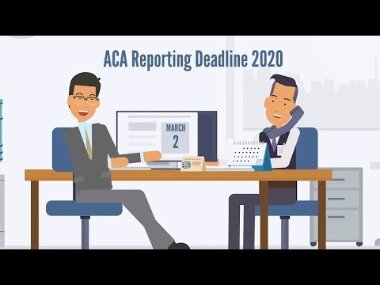Form 1095

Content

Form 1095-C is to be furnished and filed for each employee who was full-time for one or more months of a year and includes details of any health-care coverage offered to the employee, reported on a monthly basis. ACA compliance solutions are designed to keep your company compliant while reducing your human resources workload. The best software offerings will provide efficient, penalty-free compliance management in addition to detailed reporting. Some solutions are an add-on tool to your payroll or benefits administration software. Others are full service third-party companies who personally handle your filing, similar to how a PEO operates. In this guide, you can expect to find helpful advice for picking the right one for your organization, including key benefits, pitfalls, thoughts and more.

Now all of that should come from the payroll system and be pretty straight forward for most employers. But then every employer also has to take into account special types of unpaid leaves and those hours must be included in the calculations of hours of service. Over time, it’s possible that additional types of leaves could be added to this, SO if you don’t have a good absence management system in place, it’s going to be critical that you implement one and begin tracking it. Form 1095-C will identify each employee who was full-time for one or more months, and report for each month the details of any health care coverage offered. The first Forms 1095-C must be furnished to employees by January 31, 2016 , and must be filed with the IRS in accordance with existing deadlines for Forms W-2. ACA reporter has also come to know that the IRS has issued its ‘final’ drafts of instructions for employers with guidelines to report regarding health coverage, which they offered employees last year .
Highlights From The Draft 2020 Form 1095
HR teams were handed more responsibility after the passing of the Affordable Care Act in 2010. If your company has 50 or more full-time employees, it is considered an applicable large employer under the ACA.
Prior to 2019, some employees may have referenced Form 1095-C, Part III, to determine whether a health insurance coverage shared-responsibility payment applied. However, as of January 1, 2019, the individual health coverage mandate penalty was reduced to zero as a result of the 2017 Tax Cuts and Jobs Act. Accordingly, the “Full-year health-care coverage or exempt” box has been removed from Form 1040. Health coverage information is still relevant for residents of California, the District of Columbia, New Jersey or Rhode Island, which have individual health coverage mandates in effect. Taxpayers may also rely on other information received from their employer or coverage provider for purposes of filing their returns.
What is Form 1095 C and what do I do with it?
Form 1095-C: Employer-Provided Health Insurance Offer and Coverage is a tax form reporting information about an employee’s health coverage offered by an Applicable Large Employer (ALE). The taxpayer does not fill out the form and does not file it with a tax return; employers should keep the form with their records.
5 © Copyright 2015 ADP, LLC. Proprietary and Confidential Information. Shared Responsibility Decisions and Potential Penalties Did the employer have, on average, 100 in ACA full-time employees plus full-time equivalent employees in the prior year? Does the employer offer minimum essential coverage to at least 70% in 2015 (95% in 2016) of its ACA full-time employees? The penalty for failure to offer minimum value and/or affordable coverage is a $3,000 annual penalty that will be due for each full-time employee receiving a subsidy, up to a maximum of the total number of full- time employees (minus 80 in 2015; 30 in 2016) times $2,000. Those employees may be eligible to receive a premium tax credit to buy coverage in the health insurance Marketplace. Did at least one employee receive a premium tax credit or cost-sharing subsidy in a Marketplace/Exchan ge? If you have fewer than 50 full-time and FTE employees and don’t offer health coverage, you are not subject to these reporting requirements.
This means your HR team has to file 1095-C forms with the IRS for every employee that qualifies for health insurance. It can be time consuming for your HR team to file all that paperwork, and if there is any misinformation the IRS may issue hefty fees to your organization. On August 7, 2015, the Internal Revenue Service issued drafts of forms and instructions for 2015 Forms 1094-B and 1095-B; and Forms 1094-C and 1095-C. Employers will use the Forms 1094-C and 1095-C to report health insurance coverage offered under employer-sponsored plans in accordance with Section 6056 of the Internal Revenue Code . Although Forms 1094-C and 1095-C are largely unchanged from prior versions, the instructions included some noteworthy revisions. In prior years, some employees may have referenced Form 1095-C, Part III, to determine whether a health-care coverage shared-responsibility payment applied.
New Employer Health Coverage Reporting Required
An offer of an ICHRA counts as an offer of health coverage under the employer mandate of the Affordable Care Act , is subject to the ACA’s affordability and minimum value requirements, and also affects ACA information reporting. The IRS has not yet published draft 2020 Instructions for Forms 1094-C and 1095-C. Most employees will not need Form 1095-C to prepare their income tax return.
Employers are now compelled according to ACA demands to ensure that the reporting forms of 1095 reach the hands of all employees. Employers with fewer than 50 full-time and full-time equivalent employees (non-ALE members) that do not offer health coverage are not subject to the reporting requirements.
Avoid Aca Penalties By Meeting These 2021 Irs Deadlines
Time is going to be involved to the extent that if employers have large part-time populations it is going to be critical to be able to manage those people to a true part-time status and as a result, avoid potential problems with other areas of the regulatory environment. Of most concern would probably be ERISA Section 510 which prohibits an employer from cutting back an employees’ hours resulting in that employee becoming ineligible for qualified benefits, to which they would otherwise be entitled. We are measuring different things when we talk about hours of service. We are measuring hours that are worked and are paid; we are also measuring hours that are not worked but which are paid- things like paid vacation or paid leave.
- Did at least one employee receive a premium tax credit or cost-sharing subsidy in a Marketplace/Exchan ge?
- Shared Responsibility Decisions and Potential Penalties Did the employer have, on average, 100 in ACA full-time employees plus full-time equivalent employees in the prior year?
- 5 © Copyright 2015 ADP, LLC. Proprietary and Confidential Information.
- Does the employer offer minimum essential coverage to at least 70% in 2015 (95% in 2016) of its ACA full-time employees?
- Those employees may be eligible to receive a premium tax credit to buy coverage in the health insurance Marketplace.
- The penalty for failure to offer minimum value and/or affordable coverage is a $3,000 annual penalty that will be due for each full-time employee receiving a subsidy, up to a maximum of the total number of full- time employees (minus 80 in 2015; 30 in 2016) times $2,000.
For self-insured plans, Form 1095-C must also be provided to individuals who enrolled in qualified coverage, which may include non-full-time employees and any covered spouses and dependents. ICHRAs, pronounced “ick-rahs” by benefits advisors and vendors, and created under regulations the IRS issued in June 2019, allow employers to contribute a set dollar amount each year to each eligible full-time employee, tax-free. ALEs using ICHRAs to provide ACA-compliant health coverage must fund these accounts to allow employees to purchase coverage that meets the ACA’s affordability threshold. This means that for 2020, policy premiums must not have exceeded 9.78 percent of an employee’s income. The Internal Revenue Service released the draft 2020 Forms 1094-C and 1095-C on July 13, 2020. While Form 1094-C remains the same, as expected, there are some changes to IRS Form 1095-C based on the introduction in 2020 of a new type of Health Reimbursement Account , the individual coverage HRA or ICHRA. Starting January 1, 2020, employers may offer employees an ICHRA instead of offering a traditional group health plan to reimburse medical expenses, like monthly premiums and out-of-pocket costs such as copayments and deductibles.
Pitfalls When Choosing Aca Reporting Software
Additionally, non-ALE members that offer fully insured health coverage are not subject to the reporting requirements; their insurance carrier is responsible for reporting. Employers with 50 or more full-time and FTE employees must complete and file Forms 1095-C and 1094-C, regardless of the type of coverage they provide. The Form 1095-C is a tax form sent to full-time employees of an Applicable Large Employer to indicate whether the ALE offered and/or provided group health coverage. It will provide you with information that you may need to complete your personal income tax filing. The District of Columbia Office of Tax and Revenue recently released frequently asked questions with information for entities required to file Forms 1094-C/1095-C for residents of the District. The deadline to file health coverage information for 2019 is June 30, 2020.

In subsequent tax years, the filing deadline will be 30 days after the IRS deadline, including any extensions. However, they will require a delimited file with a .txt extension rather than the IRS XML version. Applicable Large Employers are required to file an information return with the Internal Revenue Service and provide statements to full-time eligible employees about health coverage offered. This is used to administer the Employer Mandate and determines an employee’s eligibility for premium tax credit. ALEs must furnish Forms 1095-C to employees or covered individuals regarding the health insurance coverage offered to them. Individuals may use this information to determine whether, for each month, they may claim the premium tax credit on their individual income tax returns. Form 1095-C is to be furnished and filed for each employee who was full-time for one or more months of a year and includes details of any health insurance coverage offered to the employee, reported on a monthly basis.
While 80% of survey respondents may not have received an IRS penalty notice, it doesn’t mean they won’t. The federal agency has been issuing Letter 226J penalty notices to employers identified as having failed to comply with the ACA’s Employer Mandate for the 2016 tax year, and will continue to do so for subsequent tax years. ALEs—organizations that had, on average, 50 or more full-time equivalent employees during the preceding calendar year—use Form 1095-C to report whether they offered eligible employees that provides minimum essential coverage and meets the minimum value threshold. These requirements apply whether an ALE offered coverage through a group health plan or funded ICHRAs that employees used to purchase coverage for themselves and their families on an ACA marketplace exchange. Employers that are not ALE members and offer self-insured health coverage use this form to report certain information to covered individuals and the IRS about the months of coverage offered to employees. This form is also used by insurers to show coverage provided to individuals under a fully insured plan.
How do I get a 1095 form from my employer?
Form 1095-A is sent out by the health insurance exchanges (HealthCare.gov or a state-based exchange, depending on the state). This form is mailed to the IRS and to the policyholder.
Electronic filing is required for parties filing 250 or more forms. For calendar year 2020, Forms 1094-C and 1095-C are required to be filed by March 1, 2021 or March 31, 2021, if filing electronically. The Form 1095-C includes information about the health insurance coverage offered to you and, if applicable, your family. You may receive multiple Forms 1095-C if you worked for multiple applicable large employers in the previous calendar year. You may need to submit information from the form as a part of your personal tax filing.
If you have fewer than 50 full-time and FTE employees and offer a fully insured health plan, your insurer is responsible for filing the required forms with the IRS and furnishing the forms to your employees. For self-insured plans, Form 1095-C must also be provided to any individuals who enrolled in qualified coverage, which may include non-full-time employees and any covered spouses and dependents.
The HR system is going to be potentially one of the systems that’ll be involved. In many cases, employers are setting up for example two different designations for full- time employees. There’s ACA full-time, which applies solely to the ACA requirements related to health care plans and then there’s a full-time designation for everything else. Things like vacation accrual or potentially stock participation or any of the policies or programs and the designation for regular full-time could be 37 ½ hours or 40 hours a week, whatever a client may have used historically. The payroll and time and absence management systems will all be involved. The payroll is going to be critical in terms of capturing the bulk of hours of service as well as things like month, average monthly salary or Box 1, W-2 values.


